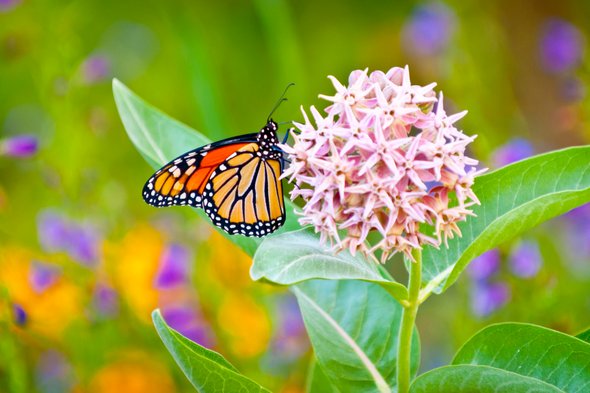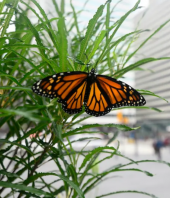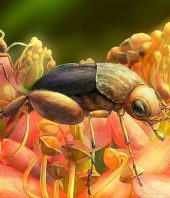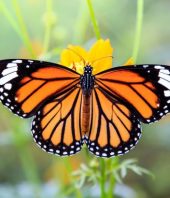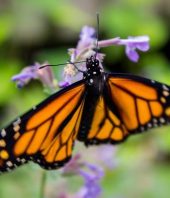Monarch butterfly populations have been declining since the 1990s, and several studies have linked this to the proliferation of crops genetically engineered to tolerate the glyphosate-based herbicide Roundup. Crops are routinely doused with it, killing all but the engineered plants—and the casualties include milkweed, on which monarchs exclusively lay their eggs. Some 850 million milkweed plants—representing 71 percent of monarchs’ support infrastructure—have vanished from corn and soybean fields in the past 20 years, according to one estimate.
While the correlation between monarch declines and herbicides is stark, consensus among scientists is not universal. Factors such as climate change, deaths during migration and loss of overwintering habitat in Mexico have also been implicated. One recent study used museum collections to show monarch numbers began falling decades before glyphosate-based herbicides were even invented—but it is drawing criticism from some ecologists who study these butterflies.
Accurately assessing insect population trends—let alone what causes them—is tricky, particularly for a migratory species. One problem is a dearth of long-term data: Nobody was consistently surveying insect communities until relatively recently. “To really know what’s happening with them, we need to have been monitoring them for a long time,” says Manu Saunders, an ecologist at the University of New England in Australia. “Of course, that hasn’t happened, and we can’t go back in time to do that now.” Last month a study in Proceedings of the National Academy of Sciences did attempt a kind of virtual time-travel, using digitized museum records of milkweed and monarch specimens dating back to 1900 to assess population trends. The analysis indicated milkweed and monarchs both started declining in the 1950s—well before the advent of glyphosate. Flush with this correlation, the authors declared that blaming monarch loss on practices involving herbicide-tolerant crops was “neither parsimonious nor well supported by data.” (Parsimony is what scientists call the simplest explanation that fits with observed evidence.)
This caught the attention of the tight-knit community of ecologists who study monarchs. The PNAS study authors had made their data freely available, and several other scientists began reevaluating it. Tyson Wepprich, an entomologist at Oregon State University, was apparently the first to identify what he says is a flaw in the study. To control for inconsistencies that might arise from idiosyncratic museum collection practices, the authors had assessed monarch abundance as a proportion of all museum specimens of Lepidoptera (the order that includes butterflies and moths). But Wepprich contends they missed the fact that Lepidoptera collection methods changed over the last century—in a way that he says favors the collection of moths.
In the 1940s lepidopterists began using light traps to collect specimens. An electric light is suspended over a collection vessel, and the device is left overnight to capture any moths that happen by and fly into the light. Light traps were game-changers; they made capturing nocturnal moths highly efficient—and according to Wepprich were responsible for museum collections’ proportional rise in moths that began in the 1950s. To correct for this, he reassessed the PNAS study data for monarch abundance as a proportion of butterflies only, and found no change from 1900 to 1980. Wepprich published his results on the preprint site bioRxiv in late February, tweeted about his issues with the paper and has also submitted a letter to PNAS. He says this changed the tone of the online conversation: It went “from people reading [the PNAS paper’s] headline and assuming glyphosate is absolved of responsibility, to people looking more critically at insect abundance claims from spotty records.”
Cornell University ecologist Anurag Agrawal, whose 2016 study was one of the first to cast doubt on milkweed loss playing an outsize role in monarch declines, thinks the PNAS paper brings important new data to an area where it is lacking. Wepprich’s criticism of the analysis is “reasonable,” Agrawal says—but the museum records “will ultimately have equal weight and equal importance to the many other [data sets] that we're trying to piece together to understand monarch declines.” The PNAS paper’s lead author, College of William & Mary ecologist Jack Boyle, also says he does not think Wepprich’s finding affects the study’s take-home message, noting that the reanalysis did not dispute the milkweed results. “But mostly we’re just happy that people are talking about this, because we’re really excited about the possibility of using museum records to figure out all sorts of things about the past,” Boyle says.
Digitization of museum collections has made a wealth of data more accessible than ever before, and this could invigorate biodiversity research. But several ecologists who were not involved in the PNAS study urged caution when using museum records to assess the abundance of a species over time. “We have no indication of where people surveyed, how much they surveyed, or where they didn’t survey,” says Elise Zipkin, an ecologist at Michigan State University, explaining that records only show whether or not a specimen was present in a museum’s collection. Leslie Ries, an ecologist at Georgetown University, agrees. “It’s really difficult to use museum records to look at abundance trends,” she says, explaining that many collections do not necessarily reflect what happened in the real world. “A lot of them come from collections where somebody did a lot of collecting in a certain area during a certain time,” and ecological models have to carefully account for that process, she says.
The implicit goal in pursuing the cause of the monarch’s decline, of course, is to stop or even reverse the trend. “We can't get anywhere unless we know what's driving” species loss, says University of Wisconsin-Madison Arboretum director* Karen Oberhauser, who founded the Monarch Larva Monitoring Project in 1996. “With monarchs we know what we’ve lost, [and] we know where we’ve lost it.” Empirically identifying the drivers of these losses gives ecologists the tools to propose policy measures and shape land-management decisions. Elizabeth Crone, an ecologist at Tufts University, recommends conducting small studies that can be scaled up to provide management recommendations. “That at least gives you answers at the scale that local land managers and higher-level conservation decision-makers want,” she says. Large data collection efforts are also useful—but like museum records they tend to have problems arising from sampling variation, Crone says.
Using multiple techniques to figure out what’s happening to a species or population is ideal, says Sarah Saunders (no relation to Manu Saunders), a conservation biologist at the National Audubon Society. “Are we coming to the same conclusions and getting similar results across different analyses and models?” she asks. “And if that's the case, then we're being pointed in a direction that seems to make a lot of sense in terms of what to suggest for recovery and conservation action.” Ultimately, protecting biodiversity is in our own best interests, Oberhauser says. “The things that are making monarchs and other species go extinct are—in the long run—going to hurt us,” she says. “By doing what we can to change these conditions so that other species don’t go extinct, we’re helping ourselves.”
Source: Scienitific American, Full Article

